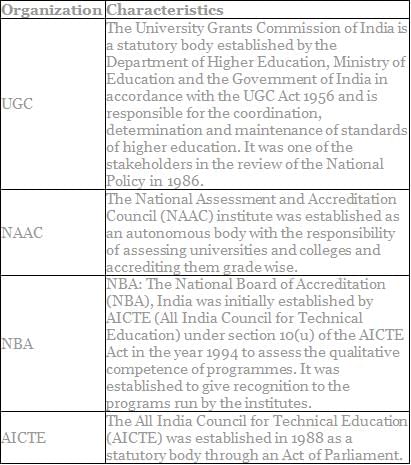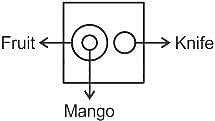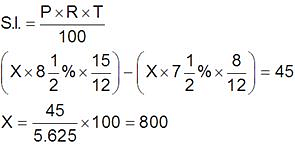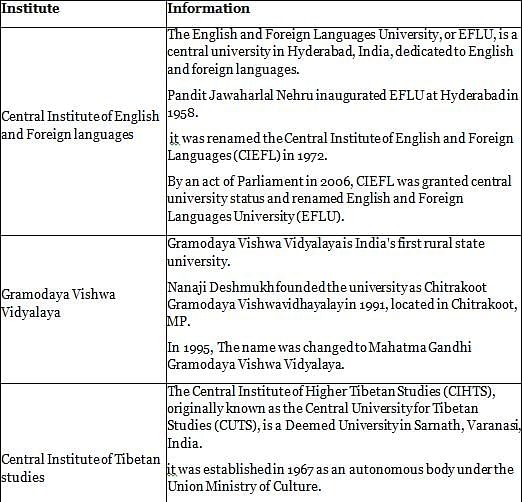APSET Paper 1 Mock Test - 5 - AP TET MCQ
30 Questions MCQ Test APSET Mock Test Series 2025 - APSET Paper 1 Mock Test - 5
Match List I with List II
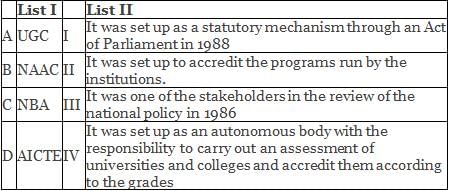
Choose the correct answer from the option given below:

Choose the correct answer from the option given below:
Direction: Select the Venn diagram that best represents the relationship between the following classes:
Mango, Fruit, Knife
Mango, Fruit, Knife
| 1 Crore+ students have signed up on EduRev. Have you? Download the App |
Which of the following is not an example of a continuous variable?
Directions: In making decisions about an important question, it is desirable to be able to distinguish between 'strong' arguments and 'weak' arguments. 'Strong' arguments are those which are both important and directly related to the question. 'Weak' arguments are those which are of minor importance and also may not be directly related to the question or may be related to a trivial aspect of the question.
The given question is followed by arguments numbered I and II. You have to decide which of the arguments is/are 'strong' argument(s) and which is/are 'weak' argument(s) and mark your answer accordingly.
Q. Should Indians shift their focus on other games rather than cricket, the much revered game in India, to improve performance in Olympics?
Arguments:
I. No, India has more important issues like malnutrition and lack of sanitation and hygiene to address.
II. Yes, many potential players have lost hope to make a career in sports due to lack of attention to other sports, as compared to cricket.
Which one of the following biosphere reserves has UNESCO recognition?
Direction: The following table presents the details about the number of players participating in three (3) different games (Football, Cricket and Badminton) from six (6) different countries (India, UK, Australia, Canada, Spain and USA) during the year
2020. Based on the date in the table, answer the question:
Country-wise Participation of players in Games
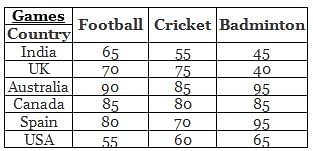
Q. What is the total number of players participating in cricket from Canada, Spain and USA and the number of players participating in Football from India, UK and Australia?
Direction: Read the information carefully and answer the following question.
For a country, CO2 emission (million metric tons) from various sectors are given in the following table.
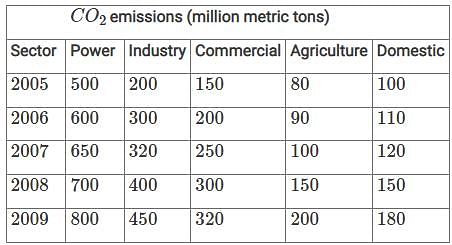
Q. What is the percentage contribution of the power sector to total CO2 emissions in the year 2008?
If the simple interest on a certain sum for 1 year 3 months at 8(1/2)% per annum exceeds the simple interest on the same sum for 8 months at 7(1/2)% per annum by Rs. 45, then the sum is
Below are given two columns, Column-A presents the stream of courses and column–B presents the name of courses. Match the two columns.

Given below are two statements:
Statement I: The goal of inquiry in fundamental research is directed at bringing an increment in the fund of knowledge.
Statement II: Action research is research by the practitioner, for the practitioner, and of the practitioner.
In the light of the above statements, choose the correct answer from the options given below:
The product of 2 number is 1280 and their HCF is square of the smallest composite number. What is the LCM of these numbers?
Match List I with List II

Choose the correct answer from the options given below:
In which of the methods of teaching ICT support is implied?
Direction: Read the following passage carefully and answer the question.
If India has to develop her internal strengths, the nation has to focus on the technological imperatives, keeping in mind three dynamic dimensions: the people, the overall economy and the strategic interests. These technological imperatives also take into account a ‘fourth’ dimension, time, an offshoot of modern-day dynamism in business, trade, and technology that leads to continually shifting targets. We believe that technological strengths are especially crucial in dealing with this fourth dimension underlying continuous change in the aspirations of the people, the economy in the global context, and the strategic interests. The progress of technology lies at the heart of human history. Technological strengths are the key to creating more productive employment in an increasingly competitive market place and to continually upgrade human skills. Without a pervasive use of technologies, we cannot achieve the overall development of our people in the years to come. The direct linkages of technology to the nation’s strategic strengths are becoming more and more clear, especially since the 1990s. India’s own strength in a number of core areas still puts it in a position of reasonable strength in the geopolitical context. Any nation aspiring to become a developed one needs to have strengths in various strategic technologies and also the ability to continually upgrade them through its own creative strengths. For people-oriented actions as well, whether for the creation of large scale productive employment or for ensuring nutritional and health security for people or for better living conditions, technology is the only vital input. The absence of greater technological impetus could lead to lower productivity and wastage of precious natural resources. Activities with low productivity or low-value addition, in the final analysis, hurt the poorest most. The technological imperatives to lift our people to a new life, and to life, they are entitled to be important. India, aspiring to become a major economic power in terms of trade and increase in GDP, cannot succeed on the strength of turnkey projects designed and built abroad or only through large-scale imports of plant machinery, equipment and know-how. Even while being alive to the short-term realities, medium and long-term strategies to develop core technological strengths within our industry are vital for envisioning a developed India.
Q.Envisioning a developed India requires :
Match List I with List II:

Choose the correct answer from the options given below:
"The sunlight is fading, which means it will be evening very soon." - This statement is a type __________ anumana.
Direction: Study the following table chart carefully and answer the question given beside.
The following table represents the Maximum marks of five subjects and marks obtained by five students in five subjects.

Q. Find the overall percentage of Sohan in all the subjects.
UNESCO published some professional requirements of a teacher, which of these are:
(A) Mastery over the subject and competency for teaching
(B) Innovativeness in approach and teaching strategies
(C) Justice to the profession of teaching
Direction: Read the following passages carefully and choose the best answer to the question.
Good health depends on several things. Fresh air and sunlight are very important for our health. Fresh air helps us to improve our immune system and overall health. So a morning walk is very useful for health. Sunlight helps our body to produce vitamin-D. A dirty and damp atmosphere causes lots of diseases. Fresh and pure drinking water is also necessary for good health. Impure drinking- water is the cause of several diseases. So, we must take care of these things. Food is another necessary thing for the body. Nutritious foods help us to maintain good health. Consumption of healthy foods helps us to minimize any health-related problems. We all should know, how, when and what to eat. We should always include a portion of green vegetables, fruits, or salads in our meals. Green vegetables are sources of vital nutrients. Our digestive system plays a key role in our overall health. Fiber-rich foods such as whole-grain wheat, bran rice, etc. help us improve our digestive system. A balanced and nutritious diet helps the proper growth of the body. But we must remember that we eat to live and not that we live to eat. In India, over-eating causes a large number of deaths. If we eat less, we may live more.
Cleanliness is essential for good health. Without cleanliness, it is very difficult to maintain proper health. We should clear our house and the surrounding areas every day. Every day, we should bathe twice, in the morning and in the evening. After eating food, we should clean our hands with soap.
Various types of diseases erupt from unclean surroundings. We should always throw the garbage in the dustbin. A disease-free body is a healthy body, and cleanliness is the key to health. We must know some simple rules of hygiene. Our house must be airy and sunny. Apart from all this, we must form good habits. We should keep ourselves free from care and anxieties. Early rising is equally necessary for good health. So we must try to keep fit. Health is the real wealth. Health is a great treasure. It is the highest blessing. It is the source of all happiness. Money can’t buy happiness. Happiness is priceless and not dependent upon the wealth of a person. Good health, however, contributes to the emotional well-being and happiness of a person. Even with limited income, a person with sound health can lead a happy and enjoyable life.
Q. What is not dependent upon the wealth of a person?
Direction: Study the following line graphs and answer the given questions.
The graph shows the ratio of marks of History to Geography of 7 students in an examination.

Q. Which of the following students got less marks in History than in Geography?
India has the largest Higher Education System in the world after:
- The United States of America
- Australia
- China
- The United Kingdom (UK)
Select the correct answer from the codes given below:
|
60 tests
|


